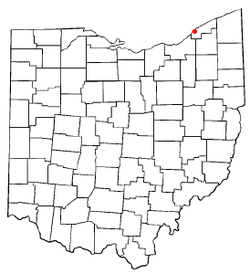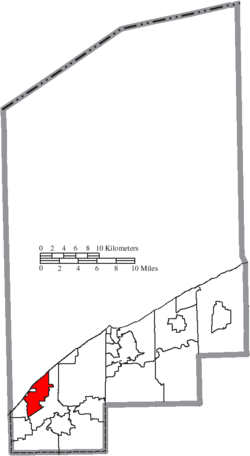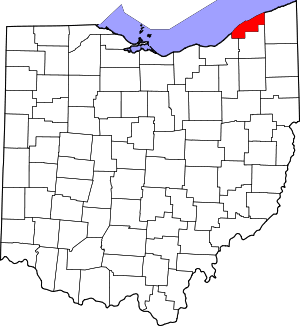Eastlake, Ohio
Eastlake is a city in Lake County, Ohio, United States. The population was 18,577 at the 2010 census. Dennis Morley is the current mayor of Eastlake. The city was named for the fact it is northeast of Cleveland, Ohio, following along the shore of Lake Erie.[7]
Eastlake, Ohio | |
|---|---|
 Location of Eastlake, Ohio | |
 Location of Eastlake in Lake County | |
| Coordinates: 41°39′40″N 81°26′7″W | |
| Country | United States |
| State | Ohio |
| County | Lake |
| Government | |
| • Mayor | Dennis Morley (I)[1] |
| Area | |
| • Total | 6.53 sq mi (16.91 km2) |
| • Land | 6.40 sq mi (16.58 km2) |
| • Water | 0.13 sq mi (0.34 km2) |
| Elevation | 620 ft (189 m) |
| Population | |
| • Total | 18,577 |
| • Estimate (2019[5]) | 18,042 |
| • Density | 2,902.7/sq mi (1,120.7/km2) |
| Time zone | UTC-5 (Eastern (EST)) |
| • Summer (DST) | UTC-4 (EDT) |
| ZIP codes | 44095, 44097 |
| Area code(s) | 440 |
| FIPS code | 39-23618[6] |
| GNIS feature ID | 1064593[3] |
| Website | https://eastlakeohio.com/ |
Eastlake is the site where Akron-based FirstEnergy's Eastlake Generating Station shut down at 1:31pm EDT on August 14, 2003, leading to the 2003 North America blackout a few hours later.
Geography
According to the United States Census Bureau, the city has a total area of 6.53 square miles (16.91 km2), of which 6.40 square miles (16.58 km2) is land and 0.13 square miles (0.34 km2) is water.[2][8]
Eastlake is about 19 miles northeast of Cleveland, Ohio, along the shore of Lake Erie, and is part of Greater Cleveland.
Demographics
94.3% spoke English and 2.9% spoke Croatian.[9]
| Historical population | |||
|---|---|---|---|
| Census | Pop. | %± | |
| 1950 | 4,700 | — | |
| 1960 | 12,467 | 165.3% | |
| 1970 | 19,690 | 57.9% | |
| 1980 | 21,954 | 11.5% | |
| 1990 | 21,161 | −3.6% | |
| 2000 | 20,255 | −4.3% | |
| 2010 | 18,577 | −8.3% | |
| Est. 2019 | 18,042 | [5] | −2.9% |
| Sources:[6][10][11][12] | |||
2010 census
As of the census[4] of 2010, there were 18,577 people, 7,841 households, and 5,056 families residing in the city. The population density was 2,902.7 inhabitants per square mile (1,120.7/km2). There were 8,280 housing units at an average density of 1,293.8 per square mile (499.5/km2). The racial makeup of the city was 95.9% White, 1.4% African American, 0.1% Native American, 1.0% Asian, 0.3% from other races, and 1.2% from two or more races. Hispanic or Latino of any race were 1.4% of the population.
There were 7,841 households of which 28.3% had children under the age of 18 living with them, 46.4% were married couples living together, 12.4% had a female householder with no husband present, 5.7% had a male householder with no wife present, and 35.5% were non-families. 29.7% of all households were made up of individuals and 11.2% had someone living alone who was 65 years of age or older. The average household size was 2.37 and the average family size was 2.93.
The median age in the city was 42.7 years. 20.6% of residents were under the age of 18; 8.3% were between the ages of 18 and 24; 24.4% were from 25 to 44; 31.3% were from 45 to 64; and 15.4% were 65 years of age or older. The gender makeup of the city was 49.3% male and 50.7% female.
2000 census
As of the census[6] of 2000, there were 20,255 people, 8,055 households, and 5,557 families residing in the city. The population density was 3,166.5 people per square mile (1,222.0/km²). There were 8,310 housing units at an average density of 1,299.1 per square mile (501.3/km²). The racial makeup of the city was 97.44% White, 0.54% African American, 0.16% Native American, 0.97% Asian, 0.01% Pacific Islander, 0.15% from other races, and 0.73% from two or more races. Hispanic or Latino of any race were 0.70% of the population. 17.1% were of German, 16.4% Italian, 15.1% Irish, 7.5% Polish, 6.1% Slovene and 5.7% English ancestry according to Census 2000.
There were 8,055 households out of which 30.6% had children under the age of 18 living with them, 53.3% were married couples living together, 11.4% had a female householder with no husband present, and 31.0% were non-families. 26.3% of all households were made up of individuals and 9.3% had someone living alone who was 65 years of age or older. The average household size was 2.51 and the average family size was 3.07.
In the city the population was spread out with 23.8% under the age of 18, 8.1% from 18 to 24, 30.3% from 25 to 44, 25.7% from 45 to 64, and 12.1% who were 65 years of age or older. The median age was 38 years. For every 100 females, there were 95.3 males. For every 100 females age 18 and over, there were 94.4 males.
The median income for a household in the city was $43,297, and the median income for a family was $52,039. Males had a median income of $37,557 versus $27,135 for females. The per capita income for the city was $19,905. About 3.7% of families and 5.0% of the population were below the poverty line, including 6.4% of those under age 18 and 6.2% of those age 65 or over.
Schools
Eastlake is located in the Willoughby-Eastlake City School District. Eastlake North High School, home of the Rangers, is one of two high schools in the district, and is located on Stevens Blvd. Eastlake Middle School and Jefferson Elementary School are located in the eastern part of the city, on the east side of the Chagrin River. Longfellow Elementary School is located in the center of the city, along Route 91 close to North High School. Washington Elementary School is in the northwestern part of the city and was closed after the 2014–2015 school year. Bryant and Stratton College is also located in Eastlake, Ohio on Curtis Blvd.
Sports and culture
Classic Park
Eastlake is home to Classic Park, the home field of the Lake County Captains, a Class A minor league baseball team affiliated with the Cleveland Indians. Classic Park's construction included controversy involving finances.[13]
Public library
Eastlake is served by a branch of the Willoughby-Eastlake Public Library.[14]
Boulevard of 500 Flags
The Boulevard of 500 Flags, purported to be "the world's largest permanent display of American flags", is located in Eastlake.[15][16][17]
Eternal Flame
"An Eternal Flame burns brightly and was donated to the City of Eastlake by the East Ohio Gas Company, commemorating the arrival of the Olympic Torch. A ceremony was held in Eastlake on June 10, 1996 as the Olympic Torch made its way through the United States from Greece to Atlanta for the 1996 Olympics. The Torch Ceremony attracted nearly 5,000 people to the area for that very special celebration."[18]
2003 Northeast blackout
On August 14, 2003, the single largest blackout in North American history occurred. The blackout caused 50 million people to lose power in eight US states and southeastern Canada.[19] Although it took months to diagnose the actual cause of the blackout, it was eventually traced back to a FirstEnergy powerplant in Eastlake, where a high-voltage power line brushed up against an overgrowth of trees causing the line to shut down, which, due to a failed alert system, caused a domino effect of power lines switching off.[20] All in all, 11 people died and around $6 billion in damages were reported, prompting the creation of a joint energy task force between the US and Canada to minimize future blackouts.
Gallery
 America Remembers 9/11 Memorial in Eastlake[21]
America Remembers 9/11 Memorial in Eastlake[21]
 Eastlake Post Office
Eastlake Post Office
References
- "Archived copy" (PDF). Archived from the original on 2018-08-15. Retrieved 2018-08-15.CS1 maint: archived copy as title (link) CS1 maint: BOT: original-url status unknown (link)
- "US Gazetteer files 2010". United States Census Bureau. Archived from the original on 2012-01-25. Retrieved 2013-01-06.
- "US Board on Geographic Names". United States Geological Survey. 2007-10-25. Archived from the original on 2012-02-12. Retrieved 2008-01-31.
- "U.S. Census website". United States Census Bureau. Retrieved 2013-01-06.
- "Population and Housing Unit Estimates". Retrieved May 21, 2020.
- "U.S. Census website". United States Census Bureau. Retrieved 2008-01-31.
- Overman, William Daniel (1958). Ohio Town Names. Akron, OH: Atlantic Press. p. 40.
- "US Gazetteer files: 2010, 2000, and 1990". United States Census Bureau. 2011-02-12. Retrieved 2011-04-23.
- "Data Center Results". www.mla.org. Retrieved 12 October 2018.
- "Number of Inhabitants: Ohio" (PDF). 18th Census of the United States. U.S. Census Bureau. 1960. Retrieved 24 April 2020.
- "Ohio: Population and Housing Unit Counts" (PDF). U.S. Census Bureau. Archived (PDF) from the original on 2014-01-09. Retrieved 22 November 2013.
- "Incorporated Places and Minor Civil Divisions Datasets: Subcounty Population Estimates: April 1, 2010 to July 1, 2012". U.S. Census Bureau. Archived from the original on 11 June 2013. Retrieved 25 November 2013.
- Glasier, David S. (2012-06-18). "Dark days, then rays of hope: A windfall relieves some of Eastlake's pain from stadium debt". The News-Herald. Retrieved 2017-05-31.
- "Locations and Hours". Willoughby-Eastlake Public Library. Archived from the original on 2017-01-12. Retrieved 2017-05-31.
- "Boulevard of 500 Flags". 500flags.org. Archived from the original on 2017-05-23. Retrieved 2017-05-31.
- Husted, Simon (2015-05-22). "Eastlake's Boulevard of 500 Flags gathering help to enforce flagpoles". The News-Herald. Retrieved 2017-05-31.
- "Boulevard of 500 Flags Photograph". Ohio History Connection. Ohio Memory Collection. 2003. Retrieved 2017-05-31.
- "Olympic Torch Eternal Flame". 500flags.org. Archived from the original on 2018-08-31. Retrieved 2017-05-31.
- "The 12 Biggest Electrical Blackouts In History". Mental Floss. Archived from the original on 2016-03-05. Retrieved 2016-02-27.
- "BLACKOUT 2003: The timeline". cleveland.com. Archived from the original on 2016-03-07. Retrieved 2016-02-27.
- "America Remembers 9-11 Memorial". 500flags.org. Archived from the original on 2018-08-31. Retrieved 2017-05-31.
